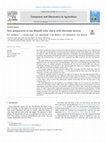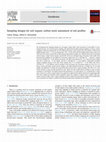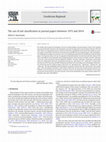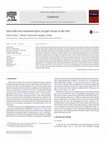Papers by Alfred E. Hartemink

Computers and Electronics in Agriculture, Dec 1, 2018
This article considers the evolution of the use of the Munsell system for assessing soil color. I... more This article considers the evolution of the use of the Munsell system for assessing soil color. In the 1920s, Munsell color disks were recommended for soil color measurement. Munsell soil color charts (MSCs) were introduced in the 1940s. In 1942, the American Standards Association recommended that spectrophotometers be used for quantitative measurements and the Munsell system be used only for the psychological characterization of color. Despite this recommendation, soil scientists have continued using MSCs to measure soil color semi-quantitatively. The utility of MSCs for color determination depends on three qualities: ambiguity, adequacy and reliability. Quantitative color was measured with a spectrophotometer. Chip colors were compared using the CIELAB color difference (ΔE ab *). To examine ambiguity, we calculated the ΔE ab * for every possible MSC color chip pair. Considerable ambiguity was found; 60% of the chips had duplicates. Chips were considered duplicates if the color difference was barely perceptible visually (ΔE ab * < 3). To investigate adequacy, the color difference between 161 soil samples and their closest MSC chips was calculated. Only 52% of the samples had ΔE ab * < 3. This indicated that the color range of the MSC does not adequately cover the range of natural soil colors. To study the reliability of MSCs, an old and a new MSC were compared. The identically designated chips in the old and new MSC generally had color differences of less than 3. Only 16% had ΔE ab * > 3. In addition, chips within a chart or even within a sheet can fade over time in a non-uniform way. On the 2.5Y sheet, a stable group of color chips (∼63%) occurred. This stable group consisted of the chips that were the least prone to discoloration (ΔE ab * < 3). This study determined that the inadequacy and ambiguity of MSCs can be overcome by using MSCs in combination with flatbed scanners. MSCs can be used to calibrate flatbed scanners for the purpose of soil color measurement. A procedure is proposed. The procedure calibrates the scanner using 7 chips from the stable group of the 2.5Y sheet. This procedure enables the measurement of soil color inexpensively and efficiently. The high efficiency of the method was confirmed by testing the accuracy of the soil color determinations for 20 soil samples, covering a wide color range. The calibration procedure quadruples the precision of color estimation compared to solely using MSCs and results in soil color measurements close to those achievable with spectrophotometers. Practically since the dawn of the U.S. Soil Survey, soil color has been a part of U.S. soil classification (Instructions to Field Parties, 1903; Simonson, 1993). Initially, soil color determination depended on individual interpretation (Instructions to Field Parties, 1914). By the early 1920s, several soil scientists had recognized the need for soil color standards (Hutton, 1921; Hendrickson, 1922; Simonson, 1993). Early proposals for the development of soil color standards focused on standardizing the contemporary system of qualitative color description, but the substitution of a numerical color system was soon
HAL (Le Centre pour la Communication Scientifique Directe), Mar 12, 2019

Geoderma Regional, 2021
Abstract Being critical to achieving Sustainable Development Goals (SDGs) of the United Nations, ... more Abstract Being critical to achieving Sustainable Development Goals (SDGs) of the United Nations, strengthening understanding of the properties and processes of soil at national and regional scales is imperative. The necessity to realize SDGs by 2030 also inspires a greater sense of responsibility and care for soils. Sustainable management of soil health is important to achieving several SDGs. Pertinent SDGs intricately connected with soil health include SDG 1 (End Poverty), 2 (Zero Hunger), 3 (Good Health and Wellbeing), 5 (Gender Equality), 6 (Clean Water and Sanitation), 7 (Affordable and Clean Energy), 9 (Industry Innovation and Infrastructure), 11 (Sustainable Cities and Communities), 12 (Responsible Consumption and Production), 13 (Climate Action), and 15 (Life on Land). Some of these SDGs rely considerably on plant production and others depend on soil processes. Pertinent among soil processes are water movement, heat transfer, sorption and physical filtration, ion exchange, and biochemical and biophysical transformations. In terms of specific accomplishments, 130 countries have aligned with the Zero Hunger Challenge, the globally available fresh water has decreased to 71% of needs, Technosols (soils whose formation is influenced by anthropogenic based materials) are used in urban ecosystems, food wastes are composted, specific targets of Land Degradation Neutrality have been signed by several countries, and soil C sequestration targets are widely implemented through initiatives such as the 4 Per Thousand (4P1000) initiative, Platform on Climate Action in Americas (PLACA), Adapting African Agriculture (AAA), Living Soils of the Americas (LiSAM), etc. In addition, policy and regulatory frameworks being widely promoted by several U.N. agencies (e.g., U.N. SDGs,limiting global warming to 1.5°C or 2 °C) can be supported by innovations in soil science including forensic soil science, remote sensing and other innovations. Soil health is becoming a central element of the research and innovation program of the EU, aiming to reach a 75% of healthy soils by 2030. In addition, the importance of soil health to human health and environmental issues is being widely promoted through educational books on soil science and secondary schools, as well as the revision of curricula. With continuous progress in movement into the digital world, transfer and communication of knowledge of the soil sciences can improve for the end users, policymakers, and the general public but additional efforts are needed. Soil science knowledge and research forms a significant contribution to specific aspects of food and nutritional security, human wellbeing, nature conservancy, and global peace and harmony. Achieving critical SDGs by 2030 can be facilitated by soil restoration and sustainable management.

Soil Systems, 2020
The COVID-19 pandemic has disrupted the global food supply chain and exacerbated the problem of f... more The COVID-19 pandemic has disrupted the global food supply chain and exacerbated the problem of food and nutritional insecurity. Here we outline soil strategies to strengthen local food production systems, enhance their resilience, and create a circular economy focused on soil restoration through carbon sequestration, on-farm cycling of nutrients, minimizing environmental pollution, and contamination of food. Smart web-based geospatial decision support systems (S-DSSs) for land use planning and management is a useful tool for sustainable development. Forensic soil science can also contribute to cold case investigations, both in providing intelligence and evidence in court and in ascertaining the provenance and safety of food products. Soil can be used for the safe disposal of medical waste, but increased understanding is needed on the transfer of virus through pedosphere processes. Strengthening communication between soil scientists and policy makers and improving distance learning ...

Soil Systems, 2019
Soil carbon storage is affected by particle-size fractions and Fe oxides. We assessed soil carbon... more Soil carbon storage is affected by particle-size fractions and Fe oxides. We assessed soil carbon concentrations in different particle-size fractions, determined the soil chemical composition of the soil, and weathering and mineralogy of sandy soils of the Wisconsin Central Sands, USA. Three land uses were studied (agriculture, forest, and prairie). The soils contained a minimum of 830 g sand kg−1 up to 190 cm soil depth. Approximately 46% of the sand was in the 250–500 μm fraction, and 5% was <125 μm. Soil carbon ranged from 5 to 13 g kg−1 in the topsoil, and decreased with depth. The <45 μm fraction tended to have high concentrations of carbon, ranging from 19 to 43 g kg−1 in the topsoil. Silicon content was over 191 g Si kg−1, and was lowest in the Bt horizons (191–224 g Si kg−1). Up to 29 g Fe kg−1 and 39 g Al kg−1 were present in the soil, and were highest in the Bt horizons. These soils were mostly quartz, and diopside was found throughout the soil profiles. Weathering i...

The role of soil organic carbon (SOC) in maintaining soil conditions and its resulting services i... more The role of soil organic carbon (SOC) in maintaining soil conditions and its resulting services is well established. Currently, over 1,000 articles per year are being published in peer-reviewed journals, and increasing at about 10% per year. It was not until the 1980s when the relation between soils and climate change was noted, and it was realized that soils play a key role as a sink and source of greenhouse gases (GHGs) ( Bouwman 1990, Scharpenseel, Ayoub and Schomaker 1990, Jenny 1980). A large number of research projects have been initiated globally in which soil C is a key component, and there have been some excellent reviews ( Lal 2004, Stockmann et al. 2013, Melillo et al. 2011). Yet, there is a lack of focus in soil C research in relation to current environmental challenges. Here we recommend research priorities to advance the knowledge base and use of soil C in relation to global human and environmental challenges: food and fiber production, water scarcity and purification,...
Geoderma, 2018
Three soil profiles in Wisconsin, USA, were sampled using a 10 × 10 cm raster: a Mollisol (1 × 1 ... more Three soil profiles in Wisconsin, USA, were sampled using a 10 × 10 cm raster: a Mollisol (1 × 1 m), Alfisol (1 × 1 m), and Entisol (1 × 0.5 m). The soils were described in the field, and samples were taken from the center of each cell. Soil organic carbon concentration, texture, and color were measured and used to revise fielddelineated horizons and their boundaries. Using soil texture, an Eb horizon was identified on the raster maps in the upper part of the field-delineated Btb horizon of the Mollisol. Soil color, soil texture, and Ti showed little lateral variation. The pH tended to vary the most laterally. The raster method characterizes soil profiles in two dimensions and can be used to quantify lateral variation and improve field delineation of soil horizons.

Geoderma, 2018
Soil thickness is an important soil characteristic changing over space and time. In this study, w... more Soil thickness is an important soil characteristic changing over space and time. In this study, we used a mechanistic soil landscape models to predict soil thickness and show it under development over time. The study was conducted in an 8,118 ha area in Vale dos Vinhedos, Rio Grande do Sul State, Brazil. Different soil production functions (SPF) combined with a landscape evolution model (LEM) were explored. The SPF calculated the soil production rates and LEM calculated erosion and deposition patterns. We evaluated two types of model. Model 1 was used to predict the current soil thickness. The model equals the erosion estimations (by a LEM) to the soil production rate (by a SPF). Three types of SPF were tested, based on a spatial variation of soil moisture. A steadystate condition was assumed, considering soil production rates similar to erosion rates. The model simulated erosion events to 1 year, using a Digital Elevation Model (DEM). A soil survey with observed soil thickness was used to validate the different models. Model 2 used the soil thickness estimation from Model 1 to simulate the soil thickness changes up to 100 kyr, considering the balance between soil production rate and soil eroded or deposited. The soil thickness changes were evaluated in different landscape positions. In Model 1, the linear correlation between observed and predicted soil thickness varied between 0.25 and 0.49, with higher linear correlation in models using soil moisture data. The RMSE under different models varied between 34 cm and 37 cm. Overall, soil depth was more accurately predicted in the upland areas than in the valley bottom areas. Model 2 suggested that the soil thickness variation largely depended on the landscape position. The average soil thickness changed from initial 67 cm (0 Kyr) to 103 cm (100 kyr).

Geoderma, 2017
We investigated four sampling designs for soil organic carbon (SOC) stock assessment of soil prof... more We investigated four sampling designs for soil organic carbon (SOC) stock assessment of soil profiles: (i) sampling by horizons, (ii) vertical transect sampling, (iii) depth-based stratified random sampling, (iv) fuzzy c-means sampling in which we explored the use of vis-NIR spectroscopy, image analysis and color models. An Alfisol and Mollisol profile wall (1 × 1 m) was divided into a 10 × 10 cm raster and 100 samples (about 200 g each) were collected at the centers of grid cells for SOC analysis. Bulk density samples were collected from each 10-cm depth interval along a single vertical transect and the SOC stock was calculated using 100 points in the profile wall. Horizon-based sampling for the Mollisol (5 horizons) ranged from 231 to 262 Mg C ha − 1 , whereas it ranged from 69 to 99 Mg C ha − 1 in the Alfisol (3 horizons). The SOC stocks obtained by 1 to 7 vertical transects ranged from 68 to 81 Mg C ha − 1 in the Alfisol, and 239 to 246 Mg C ha − 1 in the Mollisol. Depth-based stratified random sampling resulted in the SOC stocks ranging from 77 to 82 Mg C ha − 1 in the Alfisol and 234 to 257 Mg C ha − 1 in the Mollisol, and the standard errors decreased with increasing sample size from 10 to 70. Fuzzy c-means clustering created clusters similar to the field delineated horizons. A sample size of 7 in both profiles was sufficient to estimate the mean profile SOC stock by fuzzy c-means sampling. The CIE L*a*b* color model resulted in more accurate estimation in the Alfisol, but the vis-NIR spectra resulted in more accurate estimation in the Mollisol. Soil depth improved the performance of vis-NIR spectra. It is concluded that in these soils, at least two or three vertical transects are required to capture the horizontal variation for estimating profile SOC stock. Depth-wise stratified random sampling reduces the number of samples and is suitable when horizontal variation is high. Fuzzy c-means sampling is useful to determine the minimum sample size for profile SOC stock assessment but requires ancillary data and processing before sampling the soil profile.

Progress in Soil Science, 2016
Soil variation was investigated in a Mollisol soil profile wall in south central Wisconsin, USA. ... more Soil variation was investigated in a Mollisol soil profile wall in south central Wisconsin, USA. The soil was classified as a fine-loamy, mixed, superactive, mesic Pachic Argiudolls. Data were collected from a 1 × 1 m soil profile wall that was divided into a 10 × 10 cm raster. The following measurements were made: volumetric moisture content, soil pH, soil organic carbon (SOC) concentration, and elemental analysis of Al, Ca, Fe, Mn, P, Si, Ti, and Zr by portable X-ray fluorescence (pXRF). Spatial variation of soil properties was analyzed and mapped. All the soil properties demonstrated horizontal variation within the soil profile. The extent of horizontal variation changed with depth. The magnitude and direction of these changes showed no general pattern, differing between the soil properties. The SOC concentration showed constant horizontal variation at all depths except 70–80 cm. The soil pH demonstrated the lowest horizontal variation in the top 30 cm of the profile. The horizontal variation of Fe concentration tended to increase with depth. Soil property depth functions showed considerable variation between vertical transects. Only the SOC concentration and the soil pH demonstrated fairly consistent responses to changes in depth. The soil showed spatial variation within soil horizons. The soil pH and the Fe concentration showed low within-horizon variation in all soil horizons. SOC concentration showed moderate within-horizon variation in the Ap1 horizon and high within-horizon variation in the Bt horizon. Overall, the Bt horizon contained the greatest spatial variation. All soil horizons contained high within-horizon variation of at least one soil property. These results have some implications for sampling pedons.

Progress in Soil Science, 2016
Soil organic carbon (SOC) concentration differs by depth, soils, and distinct land uses. Differen... more Soil organic carbon (SOC) concentration differs by depth, soils, and distinct land uses. Different methods have been used to calculate SOC stocks, and here, we used data from 10 pedons from Southern Brazil to compare four methods: horizon values with discrete data, exponential function, equal-area exponential function, and equal-area quadratic spline function. SOC stocks were calculated up to 30 cm and 100 cm depth from (i) the original data, (ii) the standardized data based on equal mass, (iii) the standardized data based on equal mass minus coarse fragments (gravels). Results were compared calculating SOC stocks up to 30 and 100 cm depth. Discrete values by horizon produced mean SOC stocks for 30 and 100 cm depth of 6.9 and 14.6 kg/m2 for original values, 6.5 and 14.1 kg/m2 for standardized values by mass, and 6.3 and 13.5 kg/m2 for standardized values by mass minus gravels. Negative exponential functions produced mean values of 6.1 and 14.1 kg/m2 for original values, 5.6 and 13.3 kg/m2 for standardized values by equal mass, and 5.4 and 12.9 kg/m2 for standardized values by equal mass minus gravels. Equal-area exponential function had mean values of 7.1 and 14.5 kg/m2 for original values, 6.6 and 13.9 kg/m2 for standardized values by equal mass, and 6.4 and 13.5 kg/m2 for standardized values by equal mass minus gravels. Equal-area spline produced SOC averages of 6.8 and 14.7 kg/m2 for original values, 6.3 and 14.2 kg/m2 for standardized values by equal mass, and 6.1 and 13.7 kg/m2 for standardized values by equal mass minus gravels. From the comparison, we found that negative exponential functions produced lower SOC stocks than horizons in the upper layers and higher stocks than horizons in the lower layers; equal-area exponential produced SOC stocks that are statistically similar to horizon values; equal-area spline function produced values up to 30 cm depth statistically similar to horizon values and statistically different up to 100 cm depth. We can conclude that different methods for calculating SOC stocks by depth produce significantly different results and values derived from equal-area exponential and equal-area splines are more similar to those of the horizons.

Geoderma Regional, 2015
We classify soils to group our knowledge, increase our understanding, and communicate results. I ... more We classify soils to group our knowledge, increase our understanding, and communicate results. I have analyzed how soil classification and factor and soil property naming have been used in journal papers between 1975 and 2014. There is an exponential increase in the use of Taxonomy and WRB but the increase in the number of soil science papers is much faster than the use of Soil Taxonomy and WRB. The percentage of papers with soil classification information was highest in Geoderma (34%). The soil biology journals had soil classification in only 6% of their papers. Soil Taxonomy seems to be more frequently included particularly in journals from the USA, whereas FAO-Unesco and WRB are more frequently used in European journals. Soils in dry areas (Aridisols, Calcisols, Gypsisols) seem to be under-researched, whereas Spodosols (Podzols), Vertisols, Anthrosols, Chernozems, and Luvisols seem over-represented. Soil factor and property naming (e.g. "agricultural soil", "sandy soil") increase faster than the use of Soil Taxonomy and WRB. Temperate and boreal soil is commonly used in Soil Biology and Biochemistry which also tops the number of papers with forest soil, "agricultural soil", "upland soil", "wetland soil", and "valley soil". The more geologically oriented journals use parent material terms like "alluvial soils" and "granite soils". Color soil naming is common in some Chinese (black soil, red soil) and Canadian journals (Brown soil). Problems of soil classification are related to technical issues of soil classification, the adoption of the system, and the lack of instructions in soil science journals. A lack of soil classification in our papers makes transfer of information, data and results difficult.

Geoderma, 2014
Layers cemented by iron and manganese have been observed in soils of putting greens at golf cours... more Layers cemented by iron and manganese have been observed in soils of putting greens at golf courses throughout the USA. They result in reduced water infiltration, saturated conditions in the root zone, and a decline in turfgrass density and quality. The physical and chemical properties of these layers have not been investigated nor described in detail. Here we present a detailed analysis of the physicochemical properties and a conceptual pedogenetic model for the formation of Fe-cemented layers in soils of golf putting greens across the USA. These man-made soils have an A horizon of about 5 to 10 cm over 20 to 30 cm sand (C horizon) over gravel. The Fe-cemented layer is commonly found at the interface of the A and C horizons, or the C horizon and the gravel layer. Levels of total Fe in the cemented layers range from 0.41 to 16.21 g kg −1 and these are accompanied by accumulations of SOC and sometimes high levels of Mn and Al. The downward movement of water (irrigation), high levels of Fe (fertilization), and a textural discontinuity are key factors in the formation of the Fe-cemented layer. The layers may form at rates as high as 1.5 mm per year depending on Fe content and redox conditions in the root zone, and may become cemented in 10 years. These cemented layers meet the criteria of the placic horizon in Soil Taxonomy.

PLoS ONE, 2014
Estimation of carbon contents and stocks are important for carbon sequestration, greenhouse gas e... more Estimation of carbon contents and stocks are important for carbon sequestration, greenhouse gas emissions and national carbon balance inventories. For Denmark, we modeled the vertical distribution of soil organic carbon (SOC) and bulk density, and mapped its spatial distribution at five standard soil depth intervals (025, 5215, 15230, 30260 and 602 100 cm) using 18 environmental variables as predictors. SOC distribution was influenced by precipitation, land use, soil type, wetland, elevation, wetness index, and multi-resolution index of valley bottom flatness. The highest average SOC content of 20 g kg 21 was reported for 025 cm soil, whereas there was on average 2.2 g SOC kg 21 at 602100 cm depth. For SOC and bulk density prediction precision decreased with soil depth, and a standard error of 2.8 g kg 21 was found at 602100 cm soil depth. Average SOC stock for 0230 cm was 72 t ha 21 and in the top 1 m there was 120 t SOC ha 21. In total, the soils stored approximately 570 Tg C within the top 1 m. The soils under agriculture had the highest amount of carbon (444 Tg) followed by forest and semi-natural vegetation that contributed 11% of the total SOC stock. More than 60% of the total SOC stock was present in Podzols and Luvisols. Compared to previous estimates, our approach is more reliable as we adopted a robust quantification technique and mapped the spatial distribution of SOC stock and prediction uncertainty. The estimation was validated using common statistical indices and the data and high-resolution maps could be used for future soil carbon assessment and inventories.

Soil Science Society of America Journal, 2014
There is a growing need for spatially continuous and quantitative soil information for environmen... more There is a growing need for spatially continuous and quantitative soil information for environmental modeling and management, especially at the national scale. This study was aimed at predicting soil particle‐size fractions (PSF) for Nigeria using random forest model (RFM). Equal‐area quadratic splines were fitted to Nigerian legacy soil profile data to estimate PSFs at six standard soil depths (0–5, 5–15, 15–30, 30–60, 60–100, and 100–200 cm) using the GlobalSoilMap project specification. We applied an additive log‐ratio (ALR) transformation of the PSFs. There was a better prediction performance (based on 33% model validation) in the upper depth intervals than the lower depth intervals (e.g., R2 of 0.53; RMSE of 13.59 g kg−1 for clay at 0–5 cm and R2 of 0.16; RMSE of 15.60 g kg−1 at 100–200 cm). Overall, the PSFs show marked variations across the entire Nigeria region with a higher sand content compared with silt and clay contents and increasing clay content with soil depth. The va...

Outlook on Agriculture, 2013
Agriculture is the cornerstone of Rwanda's economy. The authors review how the sector has cha... more Agriculture is the cornerstone of Rwanda's economy. The authors review how the sector has changed and specifically what soil management practices are now being implemented to enhance coffee production. Coffee covers around 2.3% of total cultivated arable land, and is grown mainly by smallholder farmers on plots of less than one hectare. Rwanda produces high-quality speciality or fully washed coffee, which is intercropped with annual crops due to land scarcity to enable farmers to achieve a better combination of food and cash crops. Most of the agricultural soils have a pH of < 5.2 and are highly deficient in phosphorus. Reduced land fragmentation, increased organic and inorganic fertilizer applications and mulching are all needed to boost yields. These practices will also help to improve the soils' chemical and physical properties and control erosion on the steep cultivated slopes.

Soil Carbon, 2014
In this book, research on soil C is presented from different parts of the world, and from the fun... more In this book, research on soil C is presented from different parts of the world, and from the fundamental aspects all the way to its management at a range of temporal and spatial scales. Here we summarize a set of priorities and these are loosely grouped in: Research priorities in soil C in space and time; Research priorities in soil C properties and processes, and research priorities in Soil C use and management. A list is presented that focuses on monitoring, assessment and upscaling as well as the biochemistry and role of soil structure in the sequestration of soil C. The effect of fire, black carbon, deep carbon and hydrophobicity as well as depth distribution are important research priorities. The relation between soil C and agronomic productivity are discussed in the context of sustainable intensification for advancing global food security. Lastly, some considerations are discussed how linkages with other disciplines might enhance the impact of the soil science community in soil C research.

Uploads
Papers by Alfred E. Hartemink